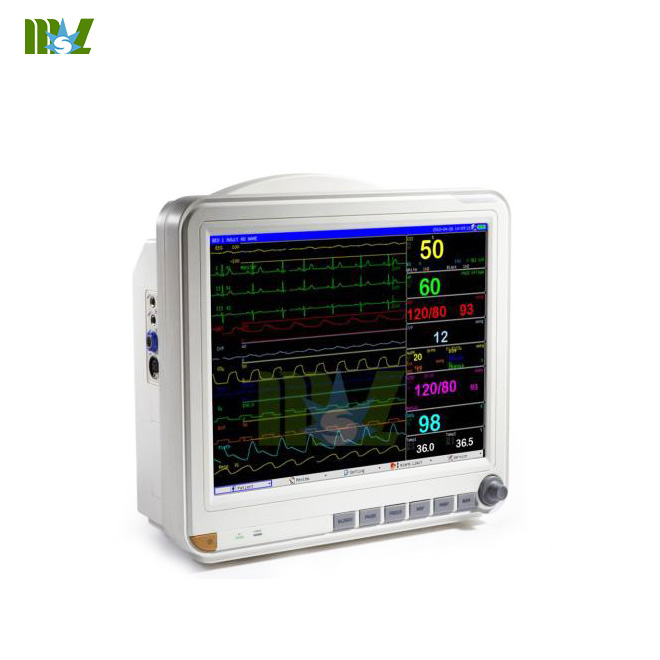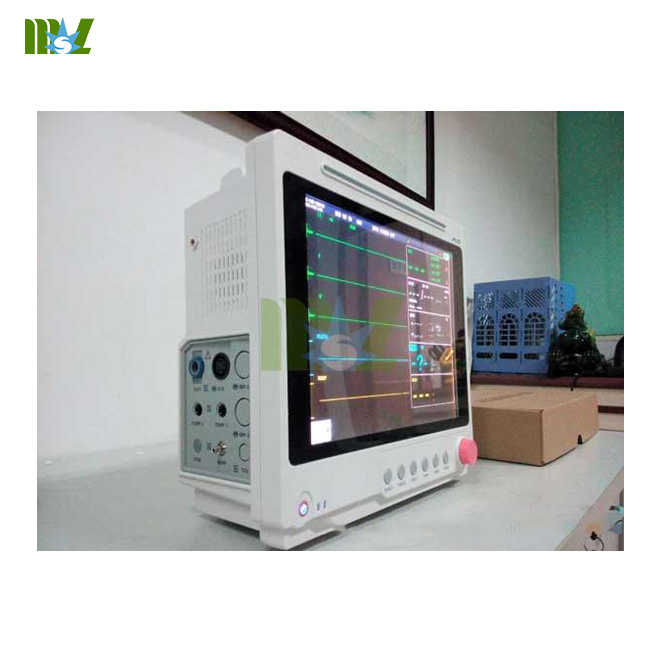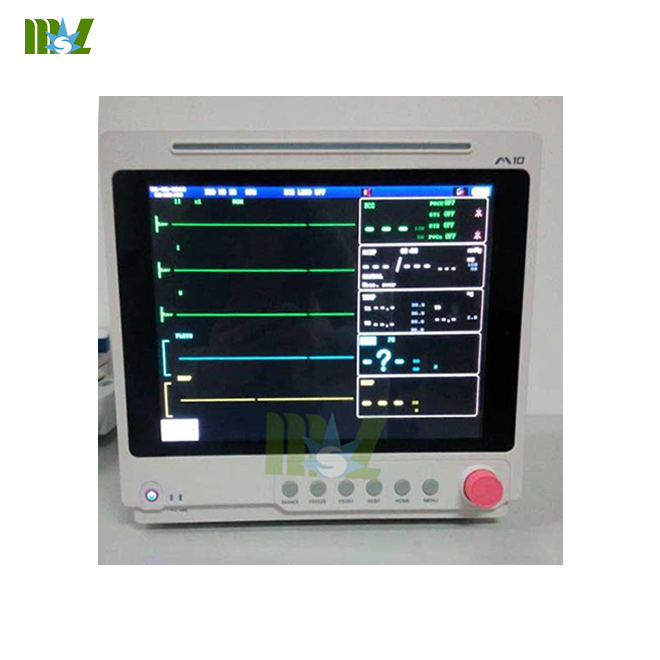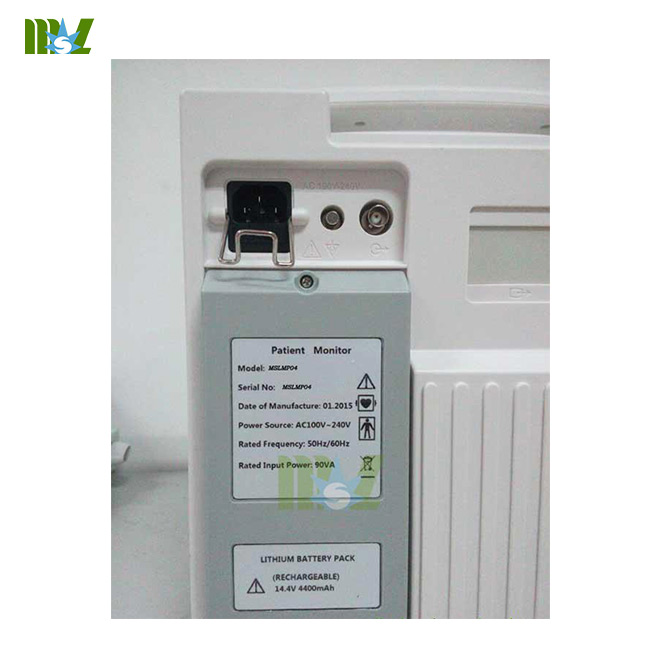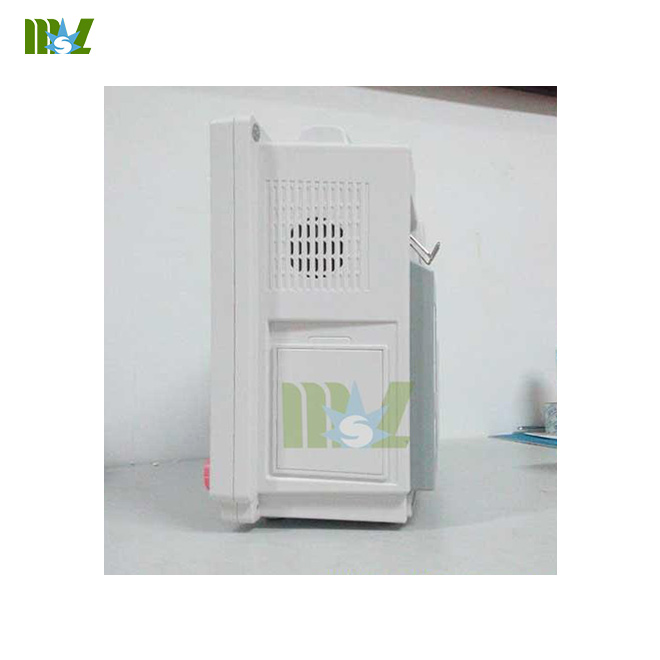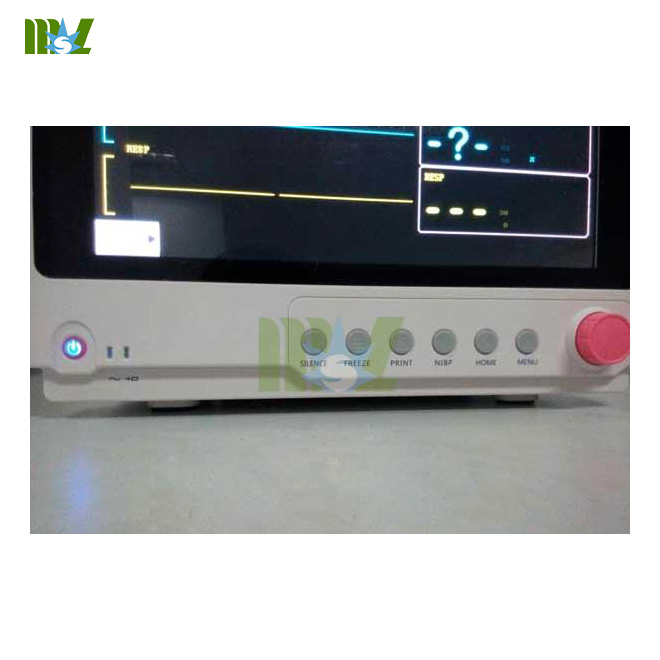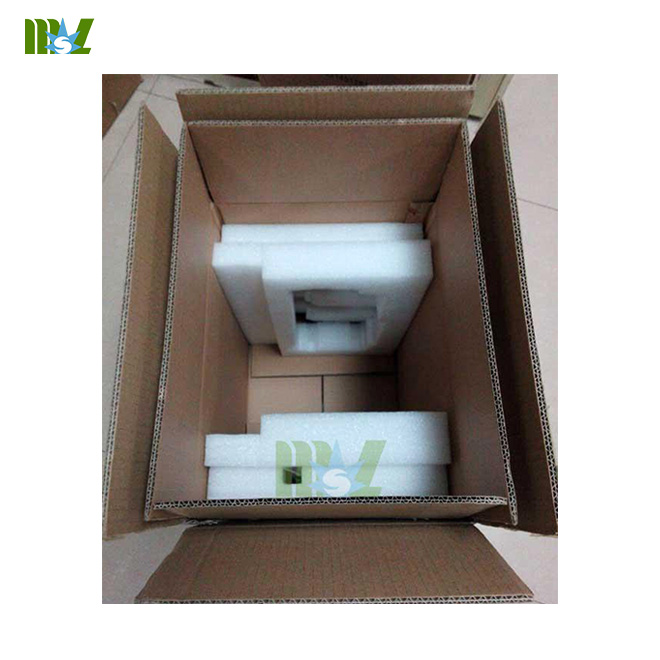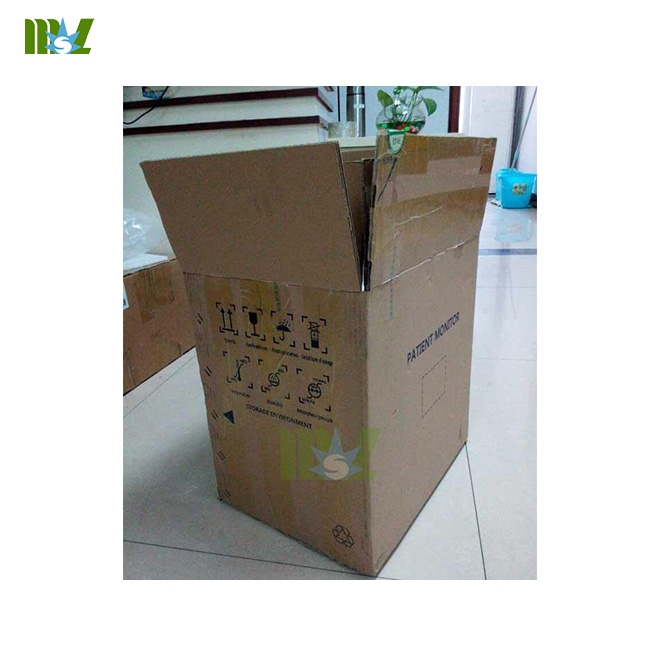-15" color TFT display,up to 14 waveforms
-One level menu,easy to use
-Parameters including ECG/RESP,SpO2,NIBP,TEMP,Pulse Rate and IBP(optional)
-Maximum 720 hour graphic and tabular trends of all parameters
-Built-in recorder and battery
-Suitable for adult,pediatric and neonatal patient
-Arrhythmia analysis,ST calculation,Pace analysis
-Anti-ESU,anti-defibrillator
-Standard network interface,can connect to Central monitor system
Desktop patient monitor MSLMP04 Main Functions:
1.Six display interface;
2.Store and recall: maximum 720 hour graphic and tabular trends of all parameters,2 hours waveform,1000 group NIBP,200 group alarm events;
3.Sound,light,voice prompt alarm;
4.Support wire or wireless WIFI networking
5.ST segment point adjustable
Desktop patient monitor MSLMP04 Standard Configuration:
1.15" widescreen TFT,Resolution ratio: 1024×768,up to 12 waveforms ;
2.Display ECG,SpO2,pulse rate,NIBP,respiration,temperature
3.Plumbic acid battery.
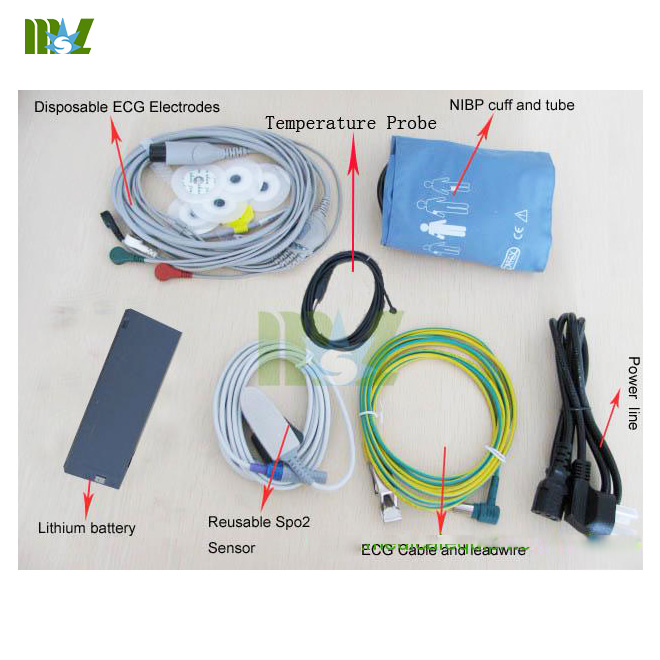
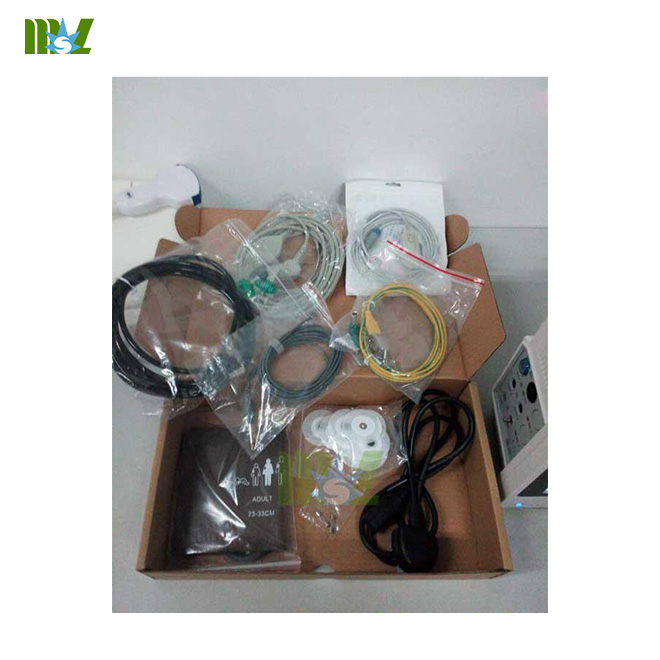
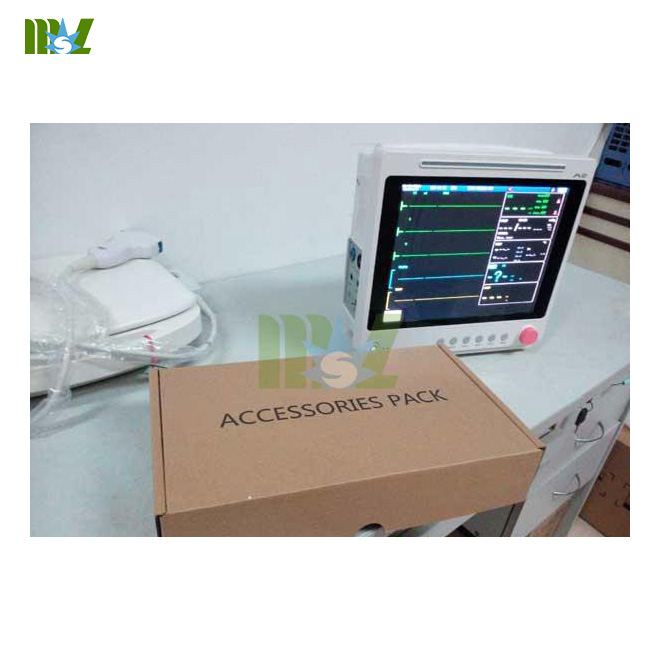
Desktop patient monitor Optional:
1.Recorder(Built-in)
2.CO2
3.Anesthesia depth
4.Anesthesia gas monitoring
5.Oxygen monitoring
1 Classification
|
Item
|
Specification
|
|
SFDA classification
|
Class II
|
|
Anti-electroshock degree
|
Class I equipment with internal power supply
|
|
Anti-electroshock degree
|
TEMP/SpO2/NIBP:
ECG/RESP
|
BF
CF
|
|
Explosion proof level
|
Ordinary equipment,without explosion proof
|
|
Harmful liquid proof degree
|
Ordinary equipment,without liquid proof
|
|
Working system
|
Continuous running equipment
|
2 Applicable standards
Medical electrical equipment GB 9706.1-2007,Part I:General requirements for safety
GB 9706.25-2005 Medical electrical equipment Part 2-27:ECG monitoring equipment safety requirements
YY 1079-2008 ECG
YY0667-2008 Medical electrical equipment Part 2:Automatic cycling non-invasive blood pressure monitoring equipment,safety and essential performance
YY0668-2008 Medical electrical equipment Part 2:multi-parameter patient monitoring equipment requirements for the safety
3 Monitor size and weight
size 365 ×300 ×160 mm
Weight 5 kg
4 Power Supply
100~240 VAC,
50/60 Hz,
Pmax=90VA Fuse T1.5A
5 Battery
2.6 Ah 12V rechargeable battery
Operating time after full charge is more than 1 hours
Operating time after the first alarm of low battery will be about 5 minutes
Maximum charging time is less than 6 hours.
6 Signal Interface
Network interface standard RJ45 Socket
7 Storage
Trend 720 hours
NIBP review 1000 NIBP events
Wave review 2 hours
Alarm review 200 alarm events
All storage data are non volatile.
8 Environment
8.1 Temperature
Working 0 ~ 40 °C
Storage -20 ~ 50°C
8.2 Humidity
Working 15%-90 % (no coagulation)
Storage 15%-90 % (no coagulation)
8.3 Atmospheric pressure
Working 86.0 kPa ~ 106.0kPa;
Storage 86.0 kPa ~ 106.0kPa
9 ECG Specification
9.1 Heart rate calculation method
Since the first occurrence of heart rate to heart rate occurred in the second interval T1;second heart rate,heart rate occurred to a third place time interval T2;continuous record 10 times,and then calculated the average interval of 10,must the heart rate per minute. 3s ~ 10s refresh every heart.
9.2 Heart rate meter accuracy and arrhythmia response
Monitor the 20s stable time after figure ECG heart rate a wave group):heart rate display 40bpm ± 5bpm;b):heart rate display 30bpm ±5bpm;c):heart rate display 120bpm±5bpm;d):heart rate display 45bpm±5bpm
A) Couple rhythm — two waves of duration is 1500ms;if the calculation all the QRS complex,heart rate to 80bpm,if only large R wave or S-wave,the heart rate to 40bpm.
B) Slow change couple rhythm — if the calculation all the QRS complex,heart rate to calculate 60bpm,if only large waves,heart rate to 30bpm.
C) Fast couple rhythm — if the calculation all the QRS complex,heart rate as 120bpm.
D) bi-directional contraction — if you calculate the QRS complex,heart rate to calculate 90bpm,if only large waves,heart rate to 45bpm.
9.3 Lead mode
5 Leads: RA、LA、LL、RL、V;lead mode:I,II,III,AVR,AVL,AVF,V
9.4 Gain
Gain control:manually four stalls
1/4 stalls(×0.25) 2.5mm/mV;1/2 stalls (×0.50) 5.0mm/mV; 1 stall (×1) 10mm/mV;2 stalls (×2) mV 20mm/mv;
9.5 Heart rate
Measure range:
Adult 15 ~ 300 bpm
Neonatal/Pediatric 15 ~ 350 bpm
accuracy ± 1%
resolution 1 bpm
9.6 Sensitivity > 200 μV P-P
9.7 Differential Input Impedance > 5 M ohm
9.8 Bandwidth
Surgery 1 ~ 20 Hz
Monitor 0.5 ~ 40 Hz
Diagnostic 0.05 ~ 130 Hz
9.9 CMRR
Diagnostic Mode >90 dB
Monitor Mode >110 dB
Surgery Mode >110 dB
9.10 Electrode offset potential ±300mV
9.11 Input dynamic range
In any lead,the applied DC bias voltage of ± 300mV to 320mV / s rate of change of ± 5mV of the differential mode voltage,and display devices should have the capacity to respond;output signal amplitude error should not exceed ± 10% ;
9.12 pacing pulse suppression
Monitor switch is open in the pacemaker,can inhibit the range:± 2 mV ~ ± 700mV,width:0.1ms ~ 2ms,rise time:10us ~ 100μs normal QRS wave single pulse without overshoot pacing pulse does not affect heart rate calculation.
Monitor switch is open in the pacemaker,can inhibit the range:± 2 mV ~ ± 5mV,width:0.5ms ~ 2ms,rise time:10us ~ 100μs single pulse overshoot normal QRS waves of pacing pulses,without affecting heart rate calculation.
Overshoot (a0) range should 0.025ap to 0.25ap range,independent of the choice of time constant,but not more than 2mV;
Monitor switch is open in the pacemaker,pacing pulse detector inhibition of rapid ECG signal to 1V / s RTI minimum input slew rate.
9.13 QRS wave amplitude and period range between
Amplitude (p-v RTI) range:0.5mV ~ 5mV;
Width (adult monitor):70 ~ 120ms;
Width (neonatal / pediatric):40 ~ 120ms;
Set monitor mode for adults should not be less than or equal to 0.15mV amplitude QRS signal or of less than or equal to 10ms between the 1mV signal a response. For neonatal / pediatric mode,monitors allowed to respond to the above two signals to respond to either or both;
9.14 frequency voltage tolerance
Superimposed on a QRS wave signals received,and to meet tolerances of ± 10% of heart rate showed the error limits of accuracy required under the premise of the maximum frequency sine wave peak-valley kurtosis should not be less than 100μV (pv)
9.15 drift tolerance
When a 0.1Hz,amplitude 4mV (pv) of the triangular wave superimposed on a string of rate of 0.5mV,interval 100ms,repetition rate of 80bpm when the QRS wave,ECG heart rate monitor shows the error should be within 80bpm ± 8bpm;
9.16 baseline control and stability
Reset:reset recovery time is not greater than the 3s;
Baseline Stability:After boot,10s baseline drift in the output rate should not exceed 10μV / s RTI;
After boot,1h,total drift should not exceed 500μV / s RTI;
Working temperature should not exceed 50μV / ℃
9.17 system noise
Should be not more than 30μV (p-v RTI)
9.18 Multi-channel crosstalk
Should not be imposed by the channel signal is not imposed without the signal channel output generated more than spin plus signal (multiplied by the gain) 5%;
9.19 Electro surgery interference suppression
Heart rate should not exceed the interference is not activated when the heart rate ± 10%,interfere with the duration should not exceed 10S;
9.20 pacemaker pulse display capabilities
Show an increase is not less than 0.2mV RTI;in 10s,the baseline drift is not greater than 10mm;
9.21 heart rate response time
Step increase in heart rate from 80bpm to 120bpm maximum response time of less than 10 s;
Heart rate from 80bpm to 40bpm step to reduce the maximum response time of less than 10 s;
9.22 to the alarm time
High heart rate alarm start time is less than 10 s by YY 1079-2008;
Low heart rate alarm start time is less than 10 s according to YY 1079-2008;
Cardiac stop alarm start time is less than 10 s by YY 1079-2008;
Tachycardia alarm start time is less than 10 s.
9.23 calibration signal
1mV (peak to peak),the accuracy ≤±5%
10 NIBP Specifications
10.1 Measurements
Pulse wave oscillation
10.2 Mode
Manual / Automatic / Continuous
10.3 Automatic measurement mode of measurement interval
1 minute,2 minutes,3 minutes,4 minutes,5 minutes,10 minutes,15 minutes,30 minutes,60 minutes,90 minutes,2 hours,3 hours,4 hours,8 hours
10.4 Continuous measurement mode of measurement time:5 minutes
10.5 pulse rate range:40-240 bpm
10.6 Measurement range and accuracy:Range
40 ~ 280mmHg systolic blood pressure for adults
Diastolic blood pressure 10 ~ 220mmHg
The average pressure of 20 ~ 240mmHg
40 ~ 220mmHg systolic blood pressure of children
Diastolic blood pressure 10 ~ 160mmHg
20 ~ 170mmHg mean pressure
Newborn systolic blood pressure 40 ~ 135mmHg
Diastolic blood pressure 10 ~ 100mmHg
The average pressure of 20 ~ 110mmHg
Static pressure range 0 ~ 300mmHg
Accuracy ±3mmHg static pressure
Blood pressure accuracy:the maximum average error of± 5mmHg;
Maximum standard deviation 8mmHg
10.7 overvoltage protection
Adult model 300 mmHg
Child model 240 mmHg
Neonatal model 150 mmHg
11 SpO ±Specifications
11.1 oxygen saturation
Measuring range 0 to 100%
Resolution 1%
Accuracy of 70 ~ 100%:±2%
<69%:not defined
11.2 pulse rate
Range 20 ~ 250bpm
Resolution 1bpm
Accuracy ±3bpm
12 temperature specifications
Sensor type 10K series,2.25K Series
Number of channels 2 channels
Range 0 ~ 50 ±C
Resolution of 0.1 ±C
Accuracy±0.1 ± C (sensor error not included)
13 recorder (optional)
Record width of 48 mm
Walking paper speed 25/50 mm / s
2-channel waveform tracings
Desktop patient monitor MSLMP04 detailed drawing
Desktop patient monitor MSLMP04 packaging
Our Patient Monitor factory image share
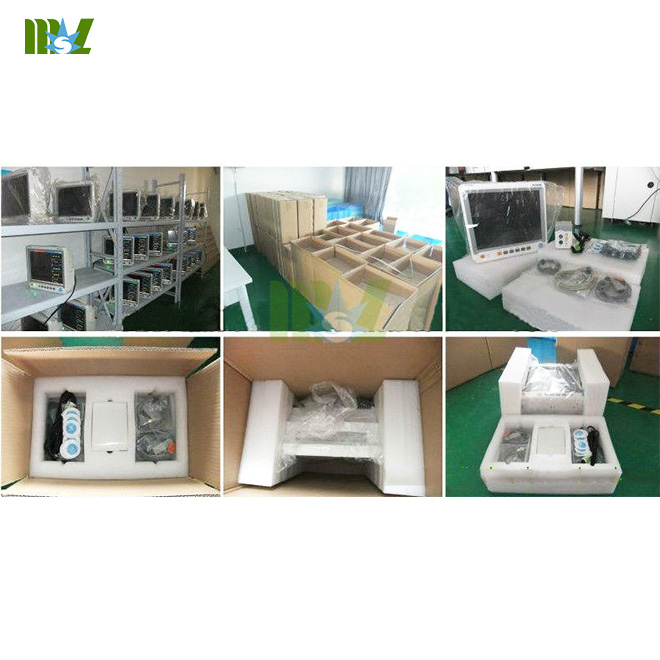
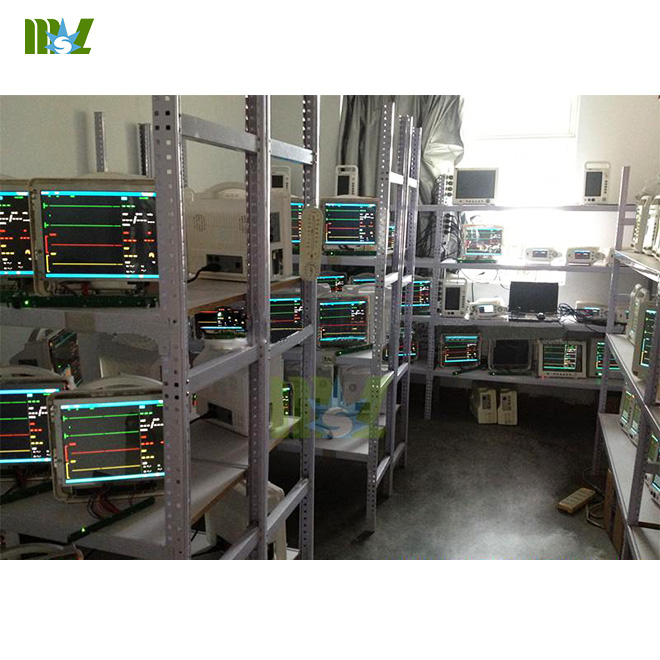

Our relate hot sale portable Patient Monitor share
Advanced 12 inch portable Patient Monitor MSLMP03 Multi-parameter(ECG,SPO2,RESP, Pulse rate, TEMP,NIBP),you can click the picture.
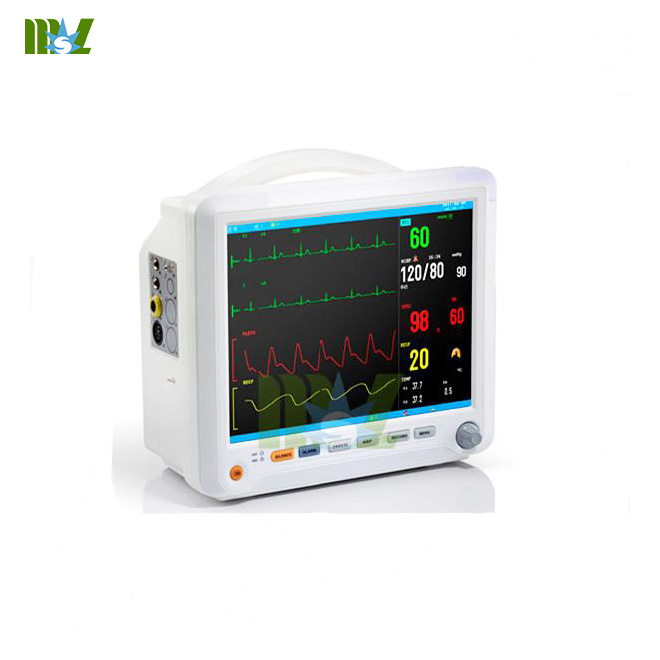
MSL Medical cooperate with DHL,FEDEX,UPS,EMS,TNT,etc.International shipping company,make your goods arrive destination safely and quickly.
MSL Certificate

